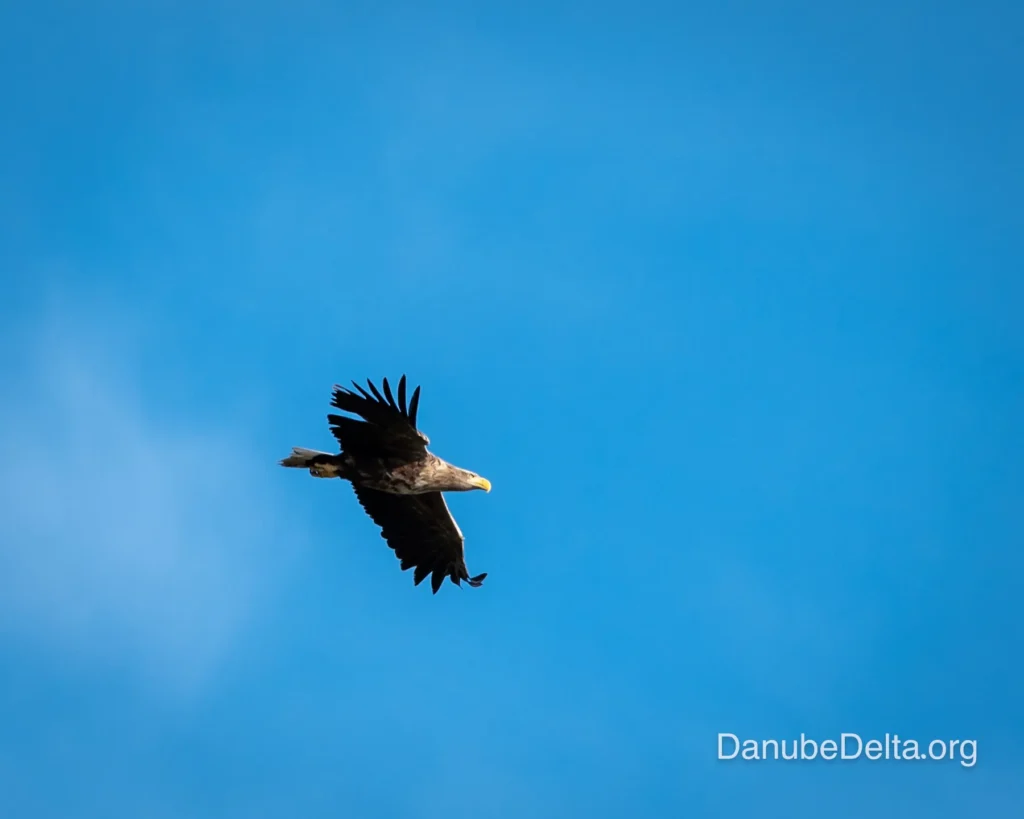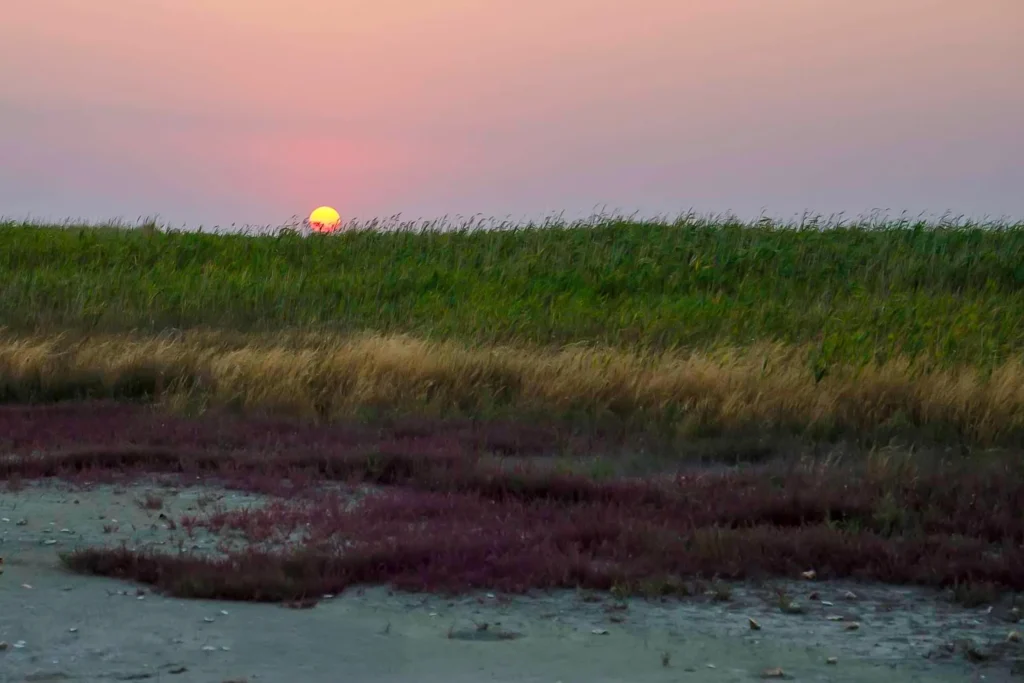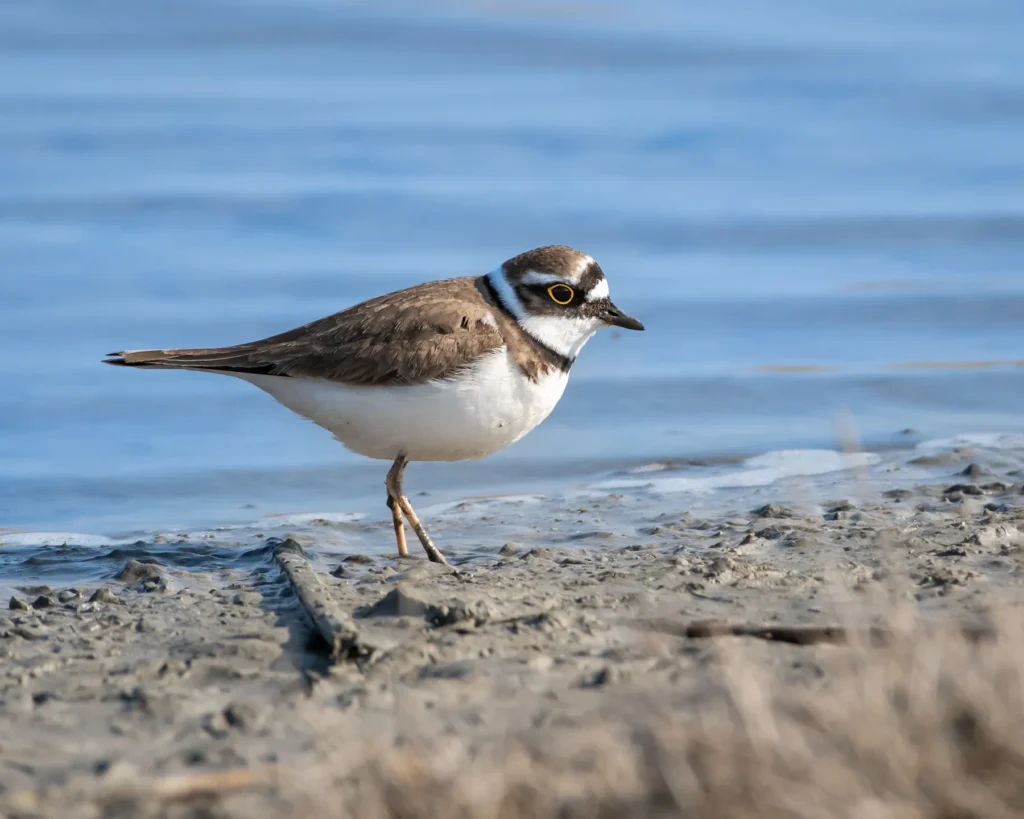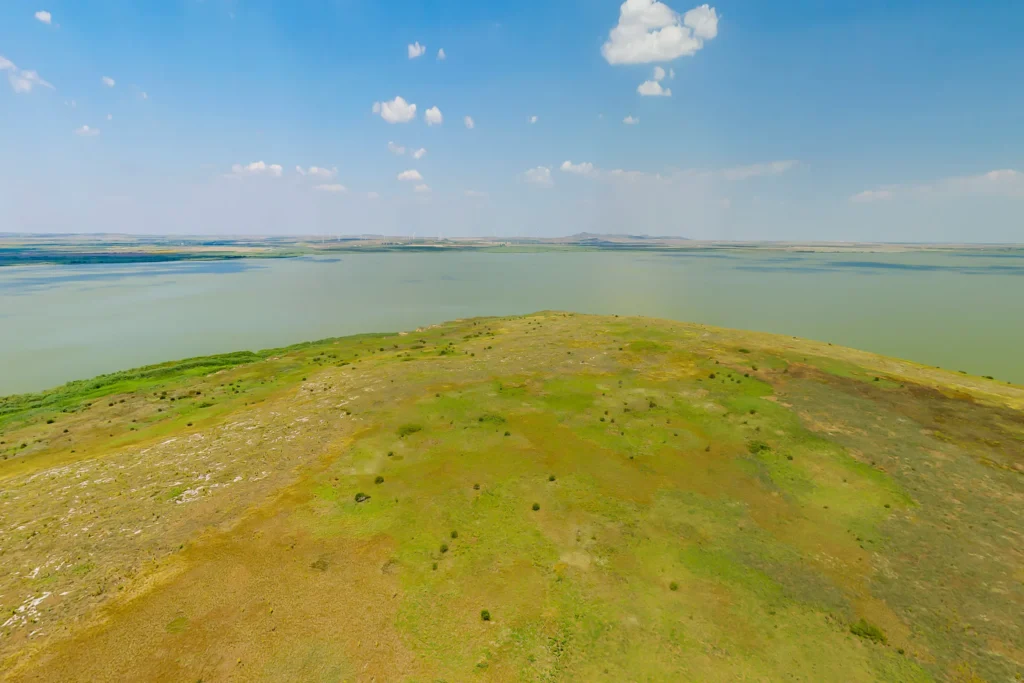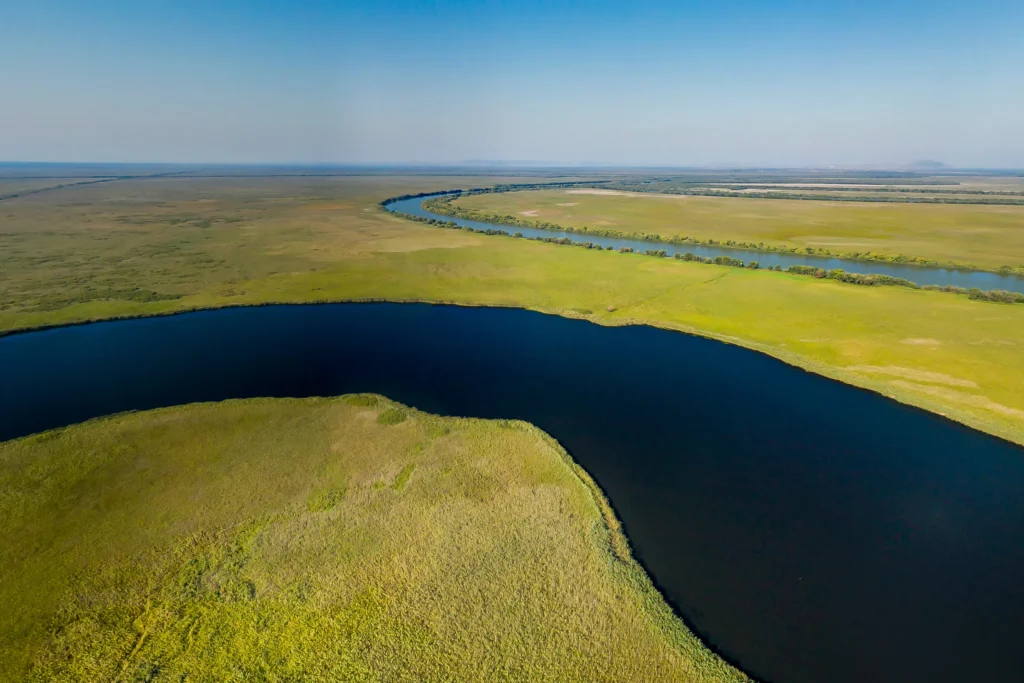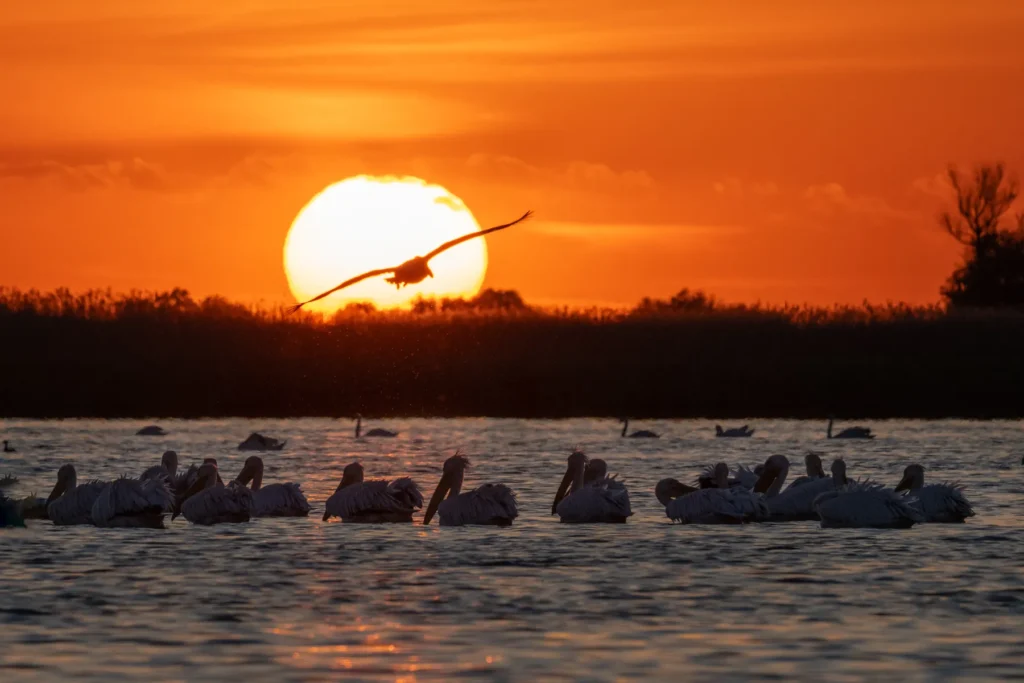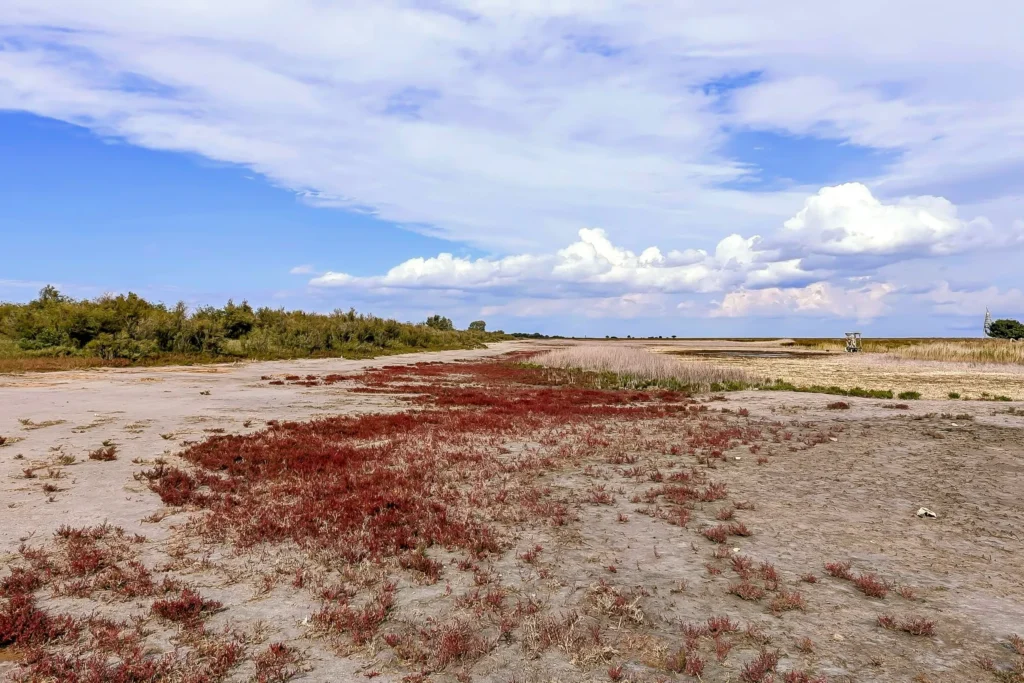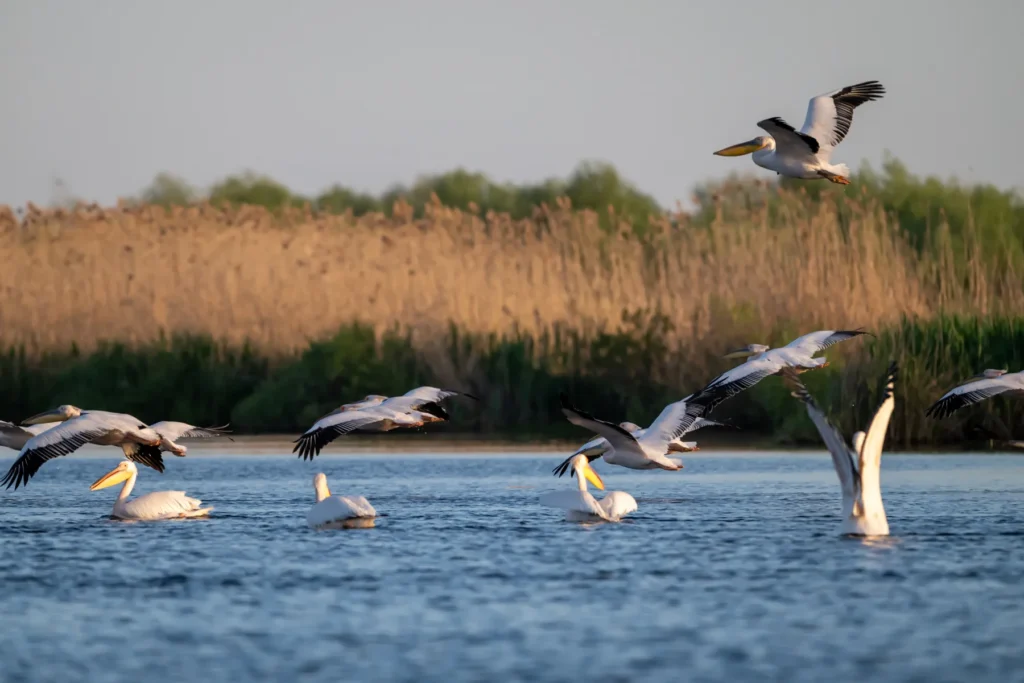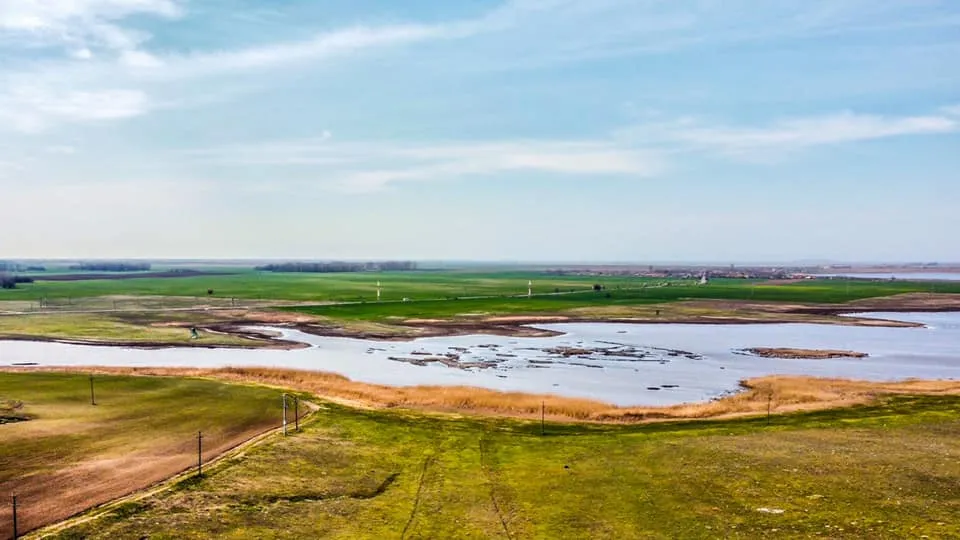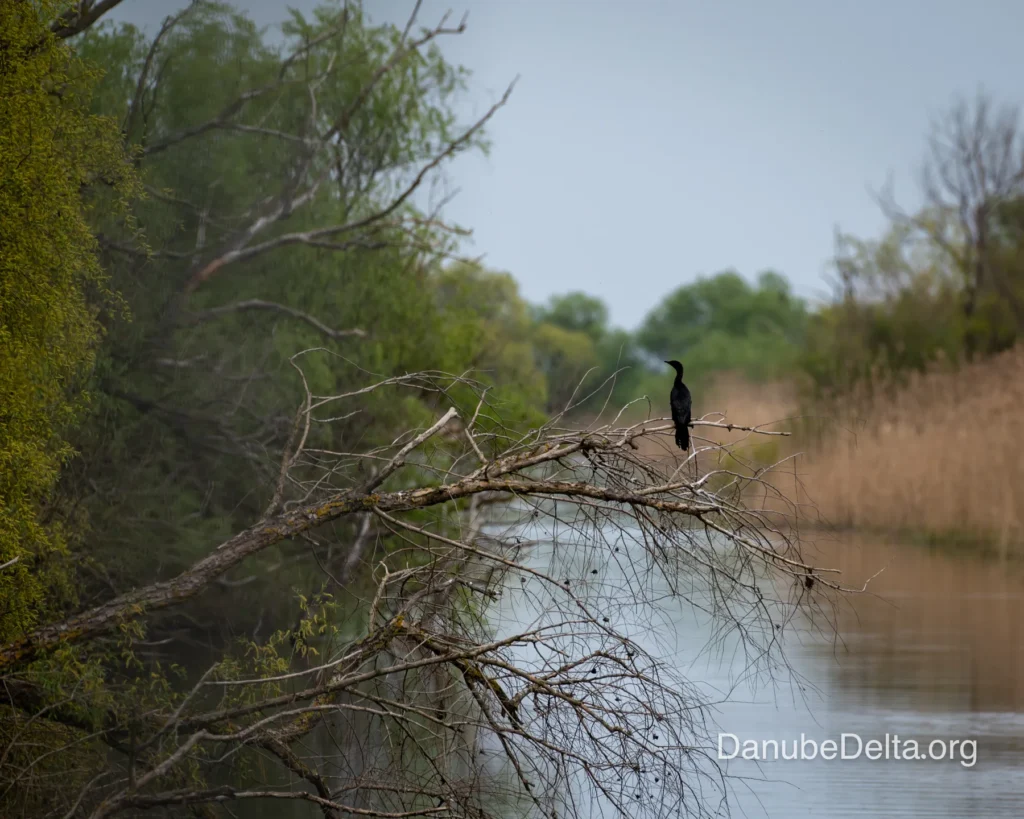Wolf Grind, a strictly protected area in the Danube Delta
Wolf Grind - Danube Delta
Wolves' Grind: Oasis of Biodiversity and Conservation in the Danube Delta
Grindul Lupilor - A Jewel of the Danube Delta
The Wolf's Grind is an essential and invaluable component of the natural heritage of the Danube Delta Biosphere Reserve (DDBBR), recognised for its almost intact ecosystems and exceptional biodiversity, and has a special status as a strictly protected area. It plays a crucial role in the conservation of many rare and endangered species and contributes significantly to the ecological health of the entire Delta.
Location and Geographical Features
Exact Positioning and Delimitation
Grindul Lupilor is a natural terrestrial formation of considerable importance, covering an area of 2,075 hectares. It is located in the southern part of the Danube Delta Biosphere Reserve, administratively included in the municipality of Mihai Viteazu, Constanța County. Its unique position within the Razim-Sinoe lagoon complex is defined by its aquatic boundaries: to the north-west it is bordered by Lake Zmeica, to the east, south and south-west by Lake Sinoe, to the west by Canal 2, and to the north by Lake Golovița. This geographic isolation, being surrounded by extensive water bodies, contributes significantly to its distinct ecological character and protected status, limiting direct access and acting as a buffer against anthropogenic impacts. The geographical coordinates that define its extent are approximately 44°41′ north latitude and 44°37′ north latitude; 28°50′ east longitude and 28°59′ east longitude.
Geology and Geomorphology
From a geological point of view, the Wolf's Sandstone is classified as a marine-lagoonal sandy sandstone. Its formation is the result of Holocene sedimentary processes, specifically the accumulation of coastal sandy coastal corridors of mixed lagoonal and marine origin. This relatively recent geological origin indicates continuous dynamics, shaped by the interaction between the Black Sea and the lagoon system. The relief is generally flat, with sand dunes described as 'almost imperceptible'. Its low altitude, varying between 0.5 and 1.5 metres above sea level, makes it particularly vulnerable to fluctuations in water level, influenced by both the flow of the Danube and the dynamics of the Black Sea.
The soils are predominantly halomorphic, i.e. affected by salts, including solonts and solonites as well as sands. They form distinct parallel bands, with Gleic solonceacs in the eastern part and Gleic, carbonate psamosols in the western part. The north-western part of the sandstone shows Molic, marshy, carbonate psamosols and Molic peaty alluvial alluvial peaty gleissols. These specific soil types are the determining factors for the unique halophytic and psammophytic vegetation thriving here.
Natural Landscape and Specific Ecosystems
The landscape of the Wolf's Grind is characterised by a predominantly flat area covered by steppe vegetation, usually between 0.5 and 1 metre high. Towards the north, numerous temporary and permanent ponds support a rich array of salt marsh vegetation. The area encompasses a mosaic of ecosystem types, including channels with active water circulation, low water exchange lakes (partly covered with floating vegetation), lagoons connected to the sea (especially Lake Sinoe), floodplain depressions with fixed xerophytic vegetation and low maritime dune meadows. The margins of the haulm are often bordered by extensive expanses of reedbeds, while the inland areas have a complex mosaic of plant associations such as Juncetum and Salicornietum. Woody vegetation, including species such as Eleagnus angustifolia (smelling willow), Hippophae rhamnoides (white marigold), Salix alba (white willow) and a dedicated pine plantation, is found exclusively in the north-western part of the Grind. This diversity of habitats contributes significantly to the rich biodiversity and overall ecological complexity of the area.
The "strip of land" character of the Wolf's Grind, almost entirely surrounded by bodies of water, indicates that its ecological stability and characteristics are fundamentally linked to the hydrological regime of the entire Razim-Sinoe lagoon complex. Its origin from Holocene sediments emphasises that it is a relatively young and geologically dynamic land formation, continuously shaped by the forces of water (lakes, sea, channels) and wind. This dynamic nature, combined with its exceptionally low elevation (0.5-1.5 metres), makes it extremely sensitive to even minor changes in water level, whether caused by natural climatic variability (e.g. droughts, floods), anthropogenic water management (e.g. Danube regularisation, dredging of channels) or long-term impacts of climate change (e.g. sea level rise, increased salinisation through marine intrusion). This deep interconnectedness and inherent vulnerability at low altitudes means that the Wolf's Gully is not a static ecological island, but a highly dynamic and fragile ecosystem. Its existence and ecological health are precarious, making it an early indicator of environmental change in the region. This vulnerability emphasises the critical importance of its "strictly protected area" status and the need for comprehensive hydrological management strategies that take into account the entire lagoon system, not just isolated components. It also emphasises the potential for rapid ecological degradation if these external pressures are not carefully managed.
Table 1: Wolf Grind - Key Features
| Main Feature | Detail |
| Surface | 2 075 ha |
| Main Location | South of the Danube Delta Biosphere Reserve, Mihai Viteazu Commune, Constanța County |
| Delimiter | Between Lake Zmeica (N), Lake Sinoe (E, S, S, S), Canal 2 (V), Lake Golovitsa (N) |
| Protected Status | Strictly Protected Area (IUCN Category IV) |
| Altitude | 0.5 - 1.5 m |
| Geological Type | Grind marine lagoon sands |
Presenting these key features in a tabular format provides a quick and easy-to-understand summary of the fundamental information. This structure enhances the user experience by allowing quick access to essential data and making it easier to retain critical information about the identity of the Wolf Grind.
Ecological Significance and Outstanding Biodiversity
Protected Status: Strictly Protected Area
Grindul Lupilor enjoys the highest level of protection within the Danube Delta Biosphere Reserve, being classified as a "Strictly Protected Area". This designation, originally established in 1961 and officially integrated into the RBDD since 1990 by Government Decision 248/1994, emphasises its exceptional ecological value. The area is classified as IUCN Category IV (Habitat/Species Management Area), which indicates the importance of active management to maintain specific habitats and species. The main reason for its designation as a Strictly Protected Area was its crucial role as a nesting and feeding refuge for birdlife, as well as a vital passage and wintering area for numerous bird species. Its well-preserved vegetation, particularly adapted to the sandy-dry soils, also contributes to its landscape value and ecological integrity.
Flora: Rare Species and Characteristic Plant Associations
The vegetation of Wolf's Grind is uniquely adapted to its environmental conditions, characterised by sandy and halomorphic (salty) soils. This adaptation has resulted in the presence of several rare and specialised plant species, including Halimione verrucifera, Holocnemum strobilacaeum, Limonium bellidifolium, Alyssum borzaeanum, Frankenia hirsuta and Onosma visianii. These species are particularly important for their ecological niche and often indicate healthy, undisturbed saline habitats. The characteristic plant associations found here reflect unique edaphic and hydrologic conditions, forming distinct communities such as Juncetum acutimaritimi, Suaedetum europaea, Salicornietum europaea, Aleuripetum littoralis, Typhaetum angutifoliae and Scirpo-Phragmitetum. These associations are crucial in providing habitat structure and food resources for local fauna. In addition to the herbaceous and halophytic flora, the presence of woody vegetation such as Eleagnus angustifolia (smelling willow), Hippophae rhamnoides (white marigold), Salix alba (white willow) and a dedicated pine plantation in the north-west, add to the diversity of the habitat, providing different ecological niches and contributing to the overall complexity of the ecosystem.
Fauna: A Vital Refuge for Birds and Mammals
The Wolves' Grind is a recognised biodiversity hotspot, particularly for its birdlife, with over 300 bird species observed. It serves as an 'important nesting and feeding refuge' and a 'haven for holidaymakers wishing to observe diverse bird species'. It is particularly vital during the autumn migration period, providing critical resting and feeding sites, as well as for wintering birds such as geese and ducks. Wading and wading birds, in particular, use salt marshes for nesting and temporary ponds for feeding.
Mammals: The area hosts valuable species protected under the Bern Convention, including Spermophilus citellus (small gopher population), a small population of Meles meles (bad badger) and golden jackal (Canis aureusThese species contribute to the food web and ecosystem health.
Reptile: Important reptile species found here include Emys orbicularis (European pond turtle), Lacerta agilis (sand lizard), Natrix natrix (house snake) and Natrix tessellata (water snake). The sandy areas in the north-west are crucial for egg-laying by aquatic reptiles, emphasising the importance of habitat integrity for their reproductive success.
Amphibians: The Grind supports a diverse amphibian population, with species such as Bombina bombina (red-bellied puddle owl), Hyla arborea (European tree frog), Bufo viridis (European green frog), Pelobates fuscus (common ground frog), Pelobates syriacus (Syrian ground frog) and Rana ridibunda (lake frog). The presence of these species indicates healthy wetland conditions.
Pisces: The area plays a role in the natural production of fish and is home to threatened fish species such as common carp and linnet, emphasising its importance for aquatic biodiversity.
Nevertebrate: The entomofauna (insect life) is exceptionally rich, forming a vital trophic base for many species of insectivorous and omnivorous birds.
Paedo saga, a large predatory grasshopper of community interest, is specifically identified, emphasising the unique diversity of invertebrates.
Crucial Ecological Role of the Wolf Grill
The "exceptional conservation quality" of the Wolf's Gorge is directly attributable to its multifunctional role as a critical habitat. It functions as a key breeding, feeding and migratory stopover area for a wide range of bird species, particularly waders and wading birds, which depend on its specific saline areas and temporary ponds. The Pontic steppes in the central and southern parts of the strict protected area are home to a large number of xerothermophilous plant species, which in turn support the rich and diverse entomofauna. This complex web of life, ranging from specialised plants to abundant insects and diverse vertebrates, underlines the indispensable role of the Wolf's Grind as a central component of the overall biodiversity and ecological resilience of the Danube Delta.
High species diversity, in particular the presence of highly specialised and sensitive species (e.g. specific halophytes, Paedo saga, various amphibians and reptiles, and migratory wading birds), indicate that the Wolf's Grind functions as a key habitat within the wider Delta ecosystem. Its unique geomorphological and edaphic conditions (sandy-dry soils, low elevation, temporary ponds) create ecological niches that are not widely available or as well preserved elsewhere. The health and stability of these specialised populations depend directly on the integrity of these specific habitat conditions. Therefore, 'outstanding conservation quality' is not just a description of current status, but a reflection of the successful conservation of these unique and fragile interdependencies. This deep ecological interdependence means that any degradation of specific habitat components (e.g. changes in salinity, hydrological regime, soil composition or human disturbance) would have disproportionately severe and cascading negative impacts on the entire food web and species community. The presence of these specialised species serves as a biological indicator; their continued thriving is evidence of effective conservation, while any decline would signal wider ecological stress within the Delta. This emphasises that the value of the area lies not just in its individual species, but in the complex and fragile ecosystem it represents, making its protection paramount for regional biodiversity.
Table 2: Biodiversity of the Wolf Grill - Representative Species
| Category Wildlife/Florist | Examples of Species/Associations |
| Rare Flora | Halimione verrucifera, Holocnemum strobilacaeum, Limonium bellidifolium, Alyssum borzaeanum, Frankenia hirsuta, Onosma visianii |
| Characteristic Plant Associations | Juncetum acutimaritimi, Suaedetum europaea, Salicornietum europaea, Aleuripetum littoralis, Typhaetum angutifoliae, Scirpo-Phragmitetum |
| Woody vegetation (in the north-west) | Eleagnus angustifolia, Hippophae rhamnoides, Salix alba, pine plantation |
| Mammals | Spermophilus citellus, Meles meles, golden jackal |
| Birds | More than 300 species (ducks, geese, red-necked geese, waders, wadariformes) |
| Reptile | Emys orbicularis, Lacerta agilis, Natrix natrix, Natrix tessellata |
| Amphibians | Bombina bombina, Hyla arborea, Bufo viridis, Pelobates fuscus, Pelobates syriacus, Rana ridibunda |
| Fish (threatened species) | Dear, lin |
| Nevertebrate | Paedo saga, rich entomofauna |
This table provides a structured and categorised overview of the rich biodiversity of the Wolf Grund. It facilitates a quick understanding of the variety of life forms supported by the area, highlighting specific examples that emphasise its ecological importance. The format improves readability and serves as a quick reference, reinforcing the area's status as a critical habitat.
Brief History and Etymology of the Name
Evolution of Protection Status in the RBDD Framework
The protection of Grindului Lupilor has a long and remarkable history, with the area having been established as a strictly protected area since 1961. This date precedes the formal establishment of the Danube Delta Biosphere Reserve as a whole, emphasising the early recognition of its significant natural value. Since 1990, the northern part of the Grindului Lupilor, which includes its entire area of 2,075 hectares, has been formally integrated as an essential component of the Danube Delta Biosphere Reserve (DDBBR), a status recognised and formalised by Government Decision No 248/1994. Integration into the wider framework of the RBDD has ensured a more comprehensive, co-ordinated and legally sound conservation approach for the Wolf's Grind, benefiting from the extensive management plans and resources of the Biosphere Reserve.
Origin and Meaning of the Name "Grindul Lupilor"
The term 'Grind' in the name 'Wolf's Grind' refers to a specific geomorphological feature: a sandy marine lagoon dune or a strip of land usually separating bodies of water or coastal areas. This description corresponds precisely to the physical nature of the area.
The "Wolves" component of the name carries a deeper, more evocative and culturally resonant meaning. Although no direct historical records are provided in the available materials that explicitly detail the origin of the name for the this specific grind, the name probably comes from a historical association with wolves in the wider region or from popular folklore. A significant indication of the name 'Wolves' comes from the fact that Lake Golovitsa, which adjoins the Wolves' Grind to the north, was 'formerly Wolves' (formerly known as 'of the wolves') This suggests a strong historical connection of the name 'wolf' with the wider lake complex, which then extended to the adjacent grind, possibly as a remnant of a larger 'wolf territory' or as a common local name.
More broadly, the 'Cult of the Wolf' is a theme deeply rooted in Geto-Dacian mythology, where the wolf was often considered a totem animal, symbolising courage, freedom and even a mythical ancestor. Although this cultural context describes a general veneration for wolves in the old Romanian lands and is not a direct etymology for the name of the Grind, it provides a rich historical and cultural background for why a natural place could be called "of the wolves". It denotes a wild, untamed and possibly historically significant wilderness area that resonated with the cultural identity of the local people. Other less well supported theories, such as a folk etymology from an Iranian word or a vague Turkish origin , are less convincing, given the stronger evidence of local patterns of historical naming and cultural significance.
The co-occurrence of the precise geological term ('grind') with the faunal reference ('wolves') in the name 'Wolf Grind' indicates a strong historical association of this specific geographical area with wolves. This is not just a descriptive name, but probably reflects a time when wolves were either common inhabitants of this wild and isolated strip of land or had an important symbolic significance for local communities. The link to Geto-Dacian mythology adds cultural depth, suggesting that the name may also derive from a wider veneration or identification with the wolf as a wild and powerful entity. The fact that the name of the adjacent lake has changed, while that of the hailstone has persisted, could imply that the hailstone, as a more rugged and less accessible feature, has retained its association with 'wildness' more strongly in local memory. The name itself thus serves as a historical artefact, providing a tangible link to the past ecology and cultural landscape of the region. It illustrates how place names can encapsulate not only geographical features, but also the historical presence of wildlife and the cultural identity of the people who inhabited and interacted with these lands. Understanding the etymology enriches the visitor's appreciation of the Wolves' Grind, transforming it into more than just a nature reserve, but a site steeped in historical and cultural significance, reinforcing the narrative of a changing natural world and the enduring human connection to it.
Conservation Measures and Current Challenges
Conservation Quality and Anthropogenic Threats
The conservation quality of the Wolf's Gorge is currently described as 'exceptional'. This high status is a direct result of its designation as a Strictly Protected Area and the ongoing efforts dedicated to conserving its unique ecosystems and biodiversity. It indicates that, despite pressures, management strategies have been largely effective in maintaining its ecological integrity.
Despite its robust protected status, the Wolf's Crane faces several significant and persistent threats, mainly anthropogenic in nature. These include general threats, widespread throughout the Danube Delta, such as unauthorised reed burning, which destroys critical habitats, and illegal human encroachment for activities such as fishing or grazing. More specific threats identified for the strictly protected areas in the Delta, which are highly relevant to the Wolff's Grouper, include unauthorised entry by 'tour operators' and fishermen using motorised boats, particularly during periods of high water when sensitive areas become more accessible. Other threats include vegetation fires, illegal hunting and unregulated camping by tourists in wild and sensitive areas, which can disturb wildlife and degrade habitats. Furthermore, road accidents involving wild animals have been observed, such as Emys orbicularis (European pond turtle) and Natrix tessellata (water snake), in the wider Sinoe - Wolf's Grind area, indicating a direct negative impact of existing infrastructure and human traffic. Therefore, 'exceptional' conservation quality is not a static state, but requires constant vigilance and active intervention to counter these ongoing pressures.
Management Plans and Protection Actions
The Wolf's Grind is managed within the framework of the comprehensive management plan of the Danube Delta Biosphere Reserve (DDBBR). The Administration of the Danube Delta Biosphere Reserve (ARBDD) is the central authority responsible for the implementation and enforcement of these conservation measures. Conservation efforts include specific and targeted measures, such as initiatives to limit the damage caused by jackals. This indicates a proactive and adaptive management approach that addresses specific ecological challenges and species interactions within the reserve. The ARBDD regularly issues and updates regulations on access, fishing bans and the establishment of protection zones. These regulatory tools are fundamental to enforcing the protected status of the Wolf Grill and mitigating various human-induced impacts. The ongoing process of development and public consultation for the RBDD management plan demonstrates a commitment to adaptive management, scientific monitoring and stakeholder engagement, ensuring that conservation strategies remain relevant and effective in the face of evolving environmental and anthropogenic pressures.
The coexistence of 'outstanding conservation quality' and an extensive list of 'threats' from human activities (unauthorised entry, fishing, motorised watercraft, fire, illegal hunting, road accidents, camping) reveals that the high conservation status of the Wolf's Gorge is not a passive, inherent state, but rather the direct result of ongoing, proactive and often difficult management and enforcement efforts. The listed anthropogenic threats are clear causal factors that, in the absence of intervention, would lead to rapid ecological degradation. ARBDD management plans, regulations, and specific interventions (such as jackal management) are necessary responses to these threats, designed to counteract negative impacts and maintain the delicate ecological balance. This illustrates a dynamic equilibrium: ecological integrity is preserved only through continuous vigilance, scientific monitoring and adaptive intervention. This understanding transforms the narrative from a simple status statement into a story of ongoing stewardship. It underscores that the beauty and biodiversity of the Wolf's Gorge is the result of deliberate human effort and commitment. For the website audience, this means that 'outstanding conservation quality' is a shared responsibility and a goal that requires their active co-operation. By highlighting specific threats and management responses, the report can foster a deeper understanding of conservation challenges and encourage responsible visitor behaviour, reinforcing the idea that their actions contribute directly to the continued preservation of this priceless natural asset.
Permits and Access Fees in the Danube Delta Biosphere Reserve
Access to the Danube Delta Biosphere Reserve (DDBBR), which includes the Wolf's Grind, is strictly regulated and requires specific permits issued by the Administration of the Danube Delta Biosphere Reserve (DDBBR), which is an essential mechanism for controlling visitor flow, ensuring responsible tourism and generating funds for conservation and management activities within the reserve.
Payment Waivers: Certain categories of people are exempt from these charges. These include children, schoolchildren, students, pensioners, pensioners, war veterans, former political prisoners, descendants of martyred and wounded heroes of the December 1989 Revolution, and individuals living in the reserve or neighbouring localities.
Payment Methods: Permits can be conveniently purchased through various channels: in cash at the ARBDD cashiers (located at the ARBDD headquarters in Tulcea) and at the designated Information Centres (available in towns such as Chilia Veche, Sulina, Crișan, Sfântu Gheorghe and Murighiol); through non-stop permit machines (available at the ARBDD headquarters, at the entrance to the tourist port of Jurilovca and at the entrance to Corbu from Năvodari); online through the official ARBDD website (permits.ddbra.ro); or by sending an SMS to the short number 7494.
Specific Rules for Visiting Strictly Protected Areas (Wolf Grind)
As a "strictly protected area", the Wolf's Grind is subject to the strictest access regulations within the Danube Delta Biosphere Reserve. While general access to the RBDD requires a permit, specific and often more restrictive rules apply to these highly sensitive areas.
General Principles for Strictly Protected Areas: For many strictly protected areas in the RBDD, "entry is strictly prohibited". However, for others, such as the Caraorman Forest, access is allowed "on foot, without noise and disturbance of birds and animals in any way". Similarly, for Prundu with Birds, it is "strictly forbidden to enter by car up to the water's edge", but "it is possible to enter on foot up to the bird observatory, with discretion, without sudden movements and without noise".
Implications for the Wolf Grind: Given its 'outstanding conservation quality' and its critical role as a major refuge for a wide range of bird species , it is highly likely that motorised access to the Wolves' Gorge would be severely restricted or completely prohibited. Any form of access, if permitted, would probably be limited to viewing on foot, requiring extreme discretion and observance of strict silence, similar to other sensitive birdwatching areas. The general rule for Strictly Protected Areas, which only allows access by 'rowing boats' off the main routes , still indicates the low impact approach required. Although some information suggests that it is a "haven for birdwatching tourists" , this should be interpreted in the context of its strictly protected status, implying highly controlled and responsible ecotourism, not open access.
Prohibited Activities (general in RBDD, with even stricter enforcement for Wolf Grind): It is generally forbidden for visitors to camp, use motorised vehicles (except authorised operational vehicles), jet skis, anchor boats, harvest or burn vegetation, damage natural habitats, abandon or release domestic animals, litter, set up permanent beach bars or structures, level unmade beaches and conduct any commercial activity within 0-150m from the waterline. These bans are amplified for strictly protected areas.
Recommendation: Due to the dynamic nature of the regulations and the specific sensitivities of strictly protected areas, visitors are strongly advised to consult the latest official regulations directly from the ARBDD website (ddbra.ro) or local information centres before planning any visit. This ensures compliance with current rules and helps to conserve the area.
Tips for a Responsible and Undisturbed Experience
To ensure the long-term conservation of the fragile ecosystem of the Wolf's Gorge and its remarkable biodiversity, visitors are urged to adhere to a strict code of behaviour. This includes maintaining absolute silence, avoiding any sudden movements that might frighten wildlife, staying strictly on designated paths (if such access is permitted) and refraining from any activities that might disturb the natural environment, such as collecting plants, disturbing animals or littering.
To navigate the reserve responsibly and understand its ecological nuances, the use of local, authorised guides is strongly recommended by the ARBDD. These guides have specialised knowledge of the area and its regulations. Prioritising low-impact methods of transport, such as electric boats or traditional rowing boats, is also strongly encouraged to minimise noise and pollution, aligning with the principles of 'slow tourism' promoted by the ARBDD.
Grindul Lupilor is a strictly protected area of exceptional ecological importance within the Danube Delta Biosphere Reserve. Its unique geographic characteristics, defined by its status as a sandy marine-lagoon sandstone surrounded by lakes, make it intrinsically fragile and sensitive to hydrological and climatic changes. This vulnerability is counterbalanced by a remarkable biodiversity, with the Wolf's Gully being a vital refuge for hundreds of species of birds, rare mammals, reptiles, amphibians and specialised flora.
Its name, "Wolves' Grind", carries a deep historical and cultural resonance, suggesting a past connection with the presence of wolves in the area and reflecting a wild landscape identity. This, together with its protected status since 1961, emphasises its enduring value.
Although the quality of conservation is considered 'exceptional', this is the result of continuous and proactive efforts by the Administration of the Danube Delta Biosphere Reserve (ARBDD) to counter persistent anthropogenic threats such as fires, unauthorised access and pollution. Active management, strict regulation and scientific monitoring are essential to maintain the dynamic ecological balance of the area.
For visitors, access to the Wolf's Gorge and the entire RBDD is regulated by specific permits and fees, with particularly strict rules for strictly protected areas. Compliance with these regulations, responsible behaviour and the use of authorised guides are imperative to ensure that this natural gem remains a biodiversity sanctuary for future generations. The Wolves' Grind is not just a destination, but a testament to the value of conservation and collective responsibility for our natural heritage.
Events in the Danube Delta
Accommodation to suit all tastes:
Whether you prefer the cosiness of modern villas, the rustic atmosphere of traditional guesthouses or the adventure of camping, they offer a variety of accommodation options to suit your needs and budget.
